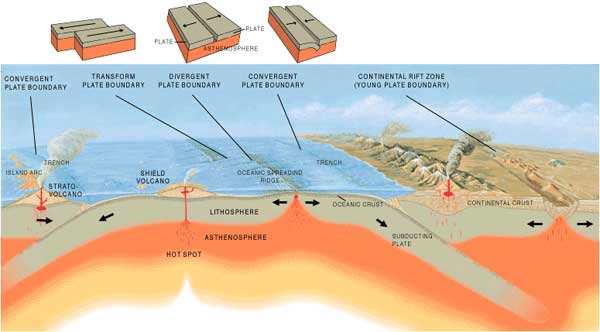 |
usa | world | animals | vocabulary | health | science | math | history |
Plate tectonics (from the Greek word for "one who constructs") is a theory of geology developed to explain the phenomenon of continental drift, and is currently the theory accepted by the vast majority of scientists working in this area. In the theory of plate tectonics the outermost part of the Earth's interior is made up of two layers, the outer lithosphere and the inner asthenosphere.
The lithosphere essentially "floats" on the asthenosphere and is broken-up into ten major plates: African, Antarctic, Australian, Eurasian, North American, South American, Pacific, Cocos, Nazca, and the Indian plates. These plates (and the more numerous minor plates) move in relation to one another at one of three types of plate boundaries: convergent (two plates push against one another), divergent (two plates move away from each other), and transform (two plates slide past one another). Earthquakes, volcanic activity, mountain-building, and oceanic trench formation occur along plate boundaries (most notably around the so-called "Pacific Ring of Fire").
Plate tectonic theory arose out of two separate geological observations: continental drift, noticed in the early 20th century, and seafloor spreading, noticed in the 1960s. The theory itself was developed during the late 1960s and has since almost universally been accepted by scientists and has revolutionized the Earth sciences (akin to the development of the periodic table for chemistry, the discovery of the genetic code for genetics, or evolution in biology).
The division of the Earth's interior into lithospheric and asthenospheric components is based on their mechanical differences. The lithosphere is cooler and more rigid, whilst the asthenosphere is hotter and mechanically weaker. This division should not be confused with the chemical subdivision of the Earth into (from innermost to outermost) core, mantle, and crust. The key principle of plate tectonics is that the lithosphere exists as separate and distinct tectonic plates, which "float" on the fluid-like asthenosphere. The relative fluidity of the asthenosphere allows the tectonic plates to undergo motion in different directions.
One plate meets another along a plate boundary, and plate boundaries are commonly associated with geological events such as earthquakes and the creation of topographic features like mountains, volcanoes and oceanic trenches. The majority of the world's active volcanoes occur along plate boundaries, with the Pacific Plate's Ring of Fire being most active and famous. These boundaries are discussed in further detail below.
Tectonic plates are comprised of two types of lithosphere: continental and oceanic lithospheres; for example, the African Plate includes the continent and parts of the floor of the Atlantic and Indian Oceans. The distinction is based on the density of constituent materials; oceanic lithospheres are denser than continental ones due to their greater mafic mineral content. As a result, the oceanic lithospheres generally lie below sea level (for example the entire Pacific Plate, which carries no continent), while the continental ones project above sea level.
There are three types of plate boundaries, characterised by the way the plates move relative to each other. They are associated with different types of surface phenomena. The different types of plate boundaries are
1. Transform boundaries occur where plates slide, or perhaps more accurately grind, past each other along transform faults. The relative motion of the two plates is either sinistral or dextral.
2. Divergent boundaries occur where two plates slide apart from each other.
3. Convergent boundaries (or active margins) occur where two plates slide towards each other commonly forming either a subduction zone (if one plate moves underneath the other) or an orogenic belt (if the two simply collide and compress).
Plate boundary zones occur in more complex situations where three or more plates meet and exhibit a mixture of the above three boundary types.
